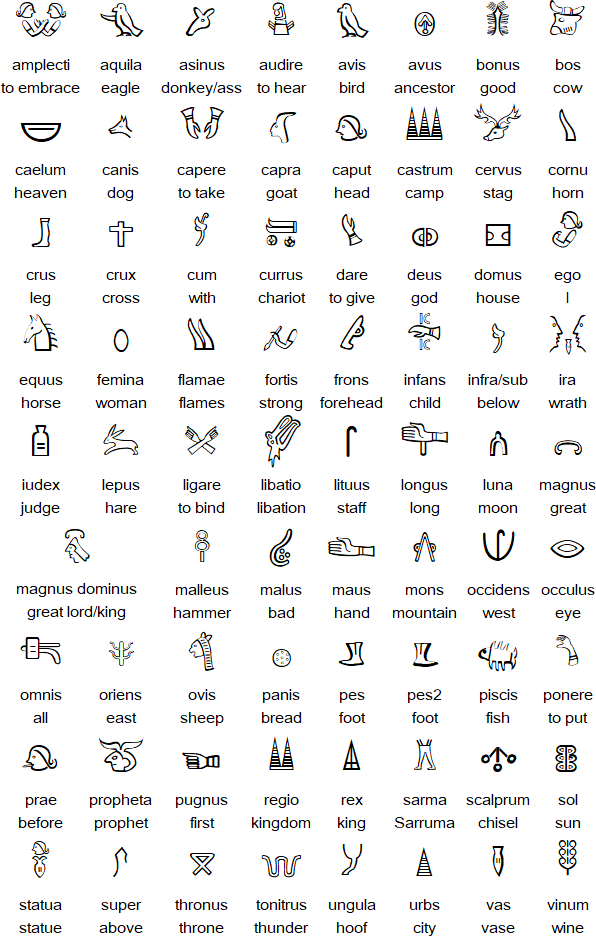Excerpts, from http://minoablog.blogspot.com/2010/10/tracking-evolution-of-ka-and-qe-signs.html Tracking the evolution of the ‘KA’ and ‘QE’ signs of Minoan Hieroglyphic and Linear scripts
<<

…..
Is the ‘sieve’ sign (Hie *47) KA or rather QE? Alone from its shape, it is impossible to decide. However, we do have a powerful help on our hand: the pictogram-like syllabary of the Phaistos Disc. Although different from the traditional Hieroglyphics, the disc does present us one clearly discernible ‘cake‘-like sign (Pha *12). While matching with Lin A QE almost perfectly in shape, it is clearly not a sieve. On the other hand, the disc also has another sign (Pha *17), that looks like a Rugby-ball with handles. That is exactly how a (handled) sieve would look if we viewed it from aside. From this point on, the identifications KA = ‘sieve’ and QE = ‘cake’ are rather straightforward. As I mentioned early in this post, there is also a somewhat cake-like ‘full circle’ sign in Minoan Hieroglyphics (Hie *73). It is much rarer than the ‘sieve’ sign, but the QE sign is also much rarer in Linear A, than the KA one (30 vs. 117 occurrances on the HT tablets). This last note essentially closes the circle. Or at least so I hope.
For those who still disbelieve these identifications, I suggest to read (or rather, parse through) the Linear A tablet HT6. It is the only case where sign QE is used as a logogram: and from the context of the tablet, it must refer to some foodstuff. Given that it stands alongside the term PI-TA (pita = Aramaic for ‘bread’), I strongly feel that the ‘cake’-sign actually meant ‘bread’. It should not be forgotten that there exists a sign (Ana *181) within Anatolian Hieroglyphics that looks similar to the Linear A QE sign and the same as Phaistos Disc sign *12. It is actually the Luwian logogram for ‘bread‘!……..>>
From https://omniglot.com/writing/luwian.htm Luwian hieroglyphic logograms See PANIS in the 7-nth row:

============================
You’re right Mr. Zeke, congratulations! As I saw myself corespondences between other (not specifically this one)proto-cuneiform signs and Aegean ones, along with Mr.I.Papakitsos and G. Kenanidis, independently, See
BERLINER BEITRAGE ZUM VORDEREN ORIENT Herausgegeben von Volkert Haas, Hartmut Kuhne, Hans J org Nissen und Johannes Renger file:///C:/Users/User/Downloads/epdf.pub_changing-views-on-ancient-near-eastern-mathematics.pdf page 29, Table “Dry cereal products and rations: ideograms” , sign GUG2a, wich is a circle with 6-10? Dots/strokes. “passim as designation of a grain product, possibly a round bread as opposed to dry grain products of all types, including simple capacity measures, qualified by GAR (cp. MSVO 1,109 obv. iii la and MSVO 1,111 rev. ii la, GUG1a together with GAR as general qualifications); often with indications of the amount of grain used in its production, usually IN18 per unit;… …”
From https://cdli.ucla.edu/tools/SignLists/protocuneiform/archsigns.html see: GUG2

and GUG2@t

Sumerian Lexicon – IS MUis.muni.cz › jaro2013 › PAPVB_13 › Halloran_version_3 PDFAug 11, 1999 — The Sumerian lexicon has benefitted from several classes at UCLA with Dr. Robert … << gug: monthly offering>>
Sumerian Beer: The Origins of Brewing Technology in Ancient Mesopotamia* Peter Damerow https://cdli.ucla.edu/pubs/cdlj/2012/cdlj2012_002.html << In the earlier proto-cuneiform documents the first of these signs (GUG2) represented a specific amount of barley processed in a certain form to be distributed as a special kind of ration prepared from grain. Based on later usage this sign is commonly translated as “cake.” >>
From http://mathscitech.org/articles/mathematics-uruk-susa
Leave a comment